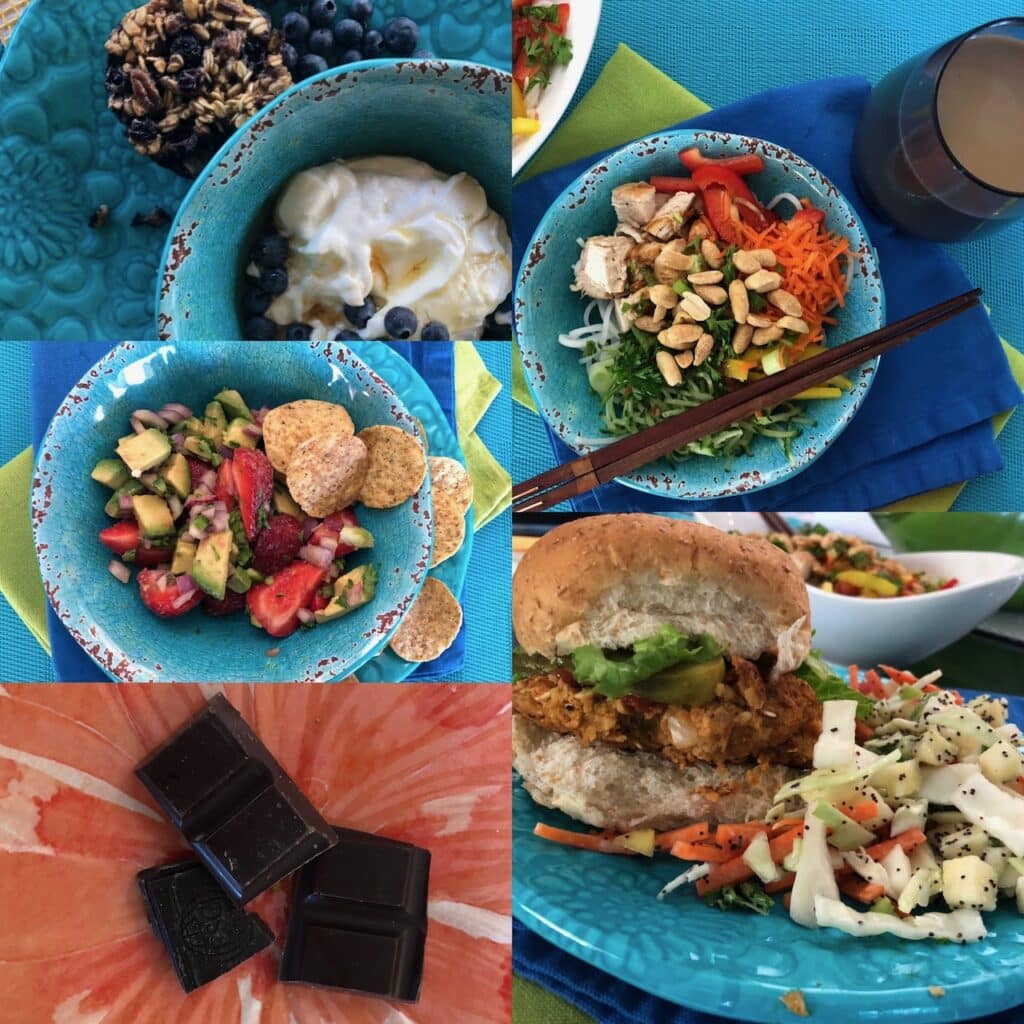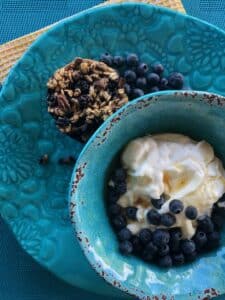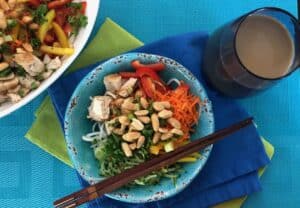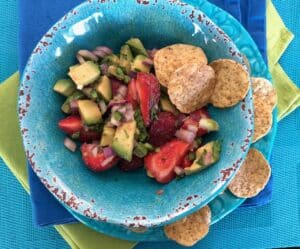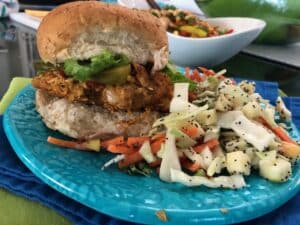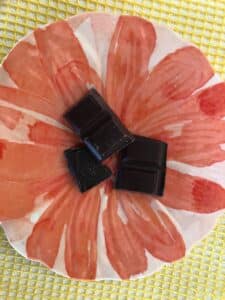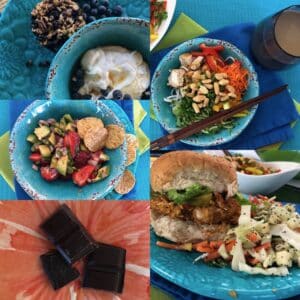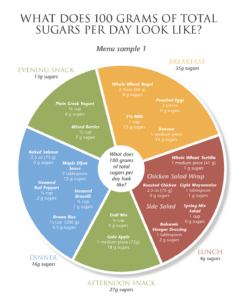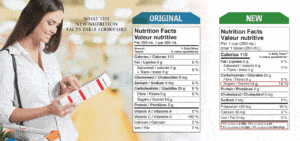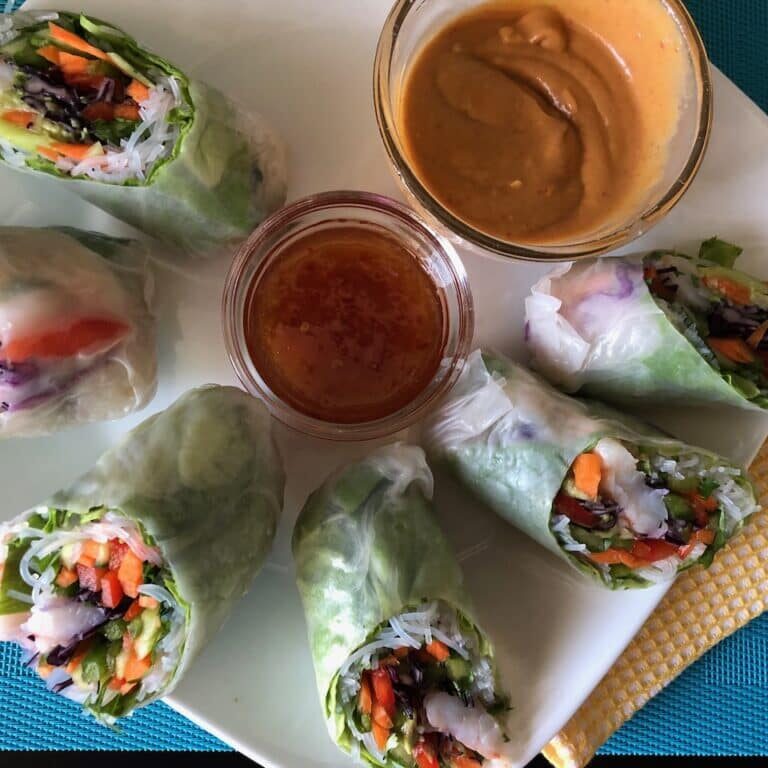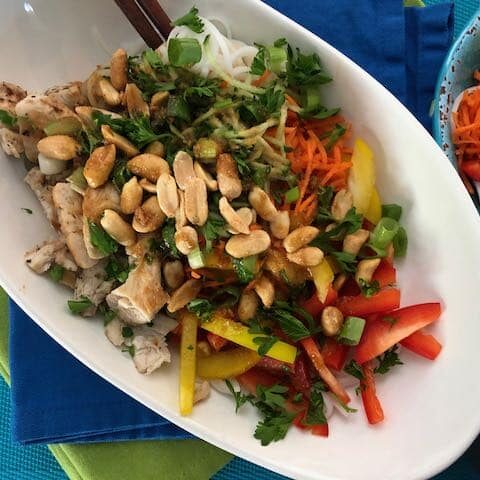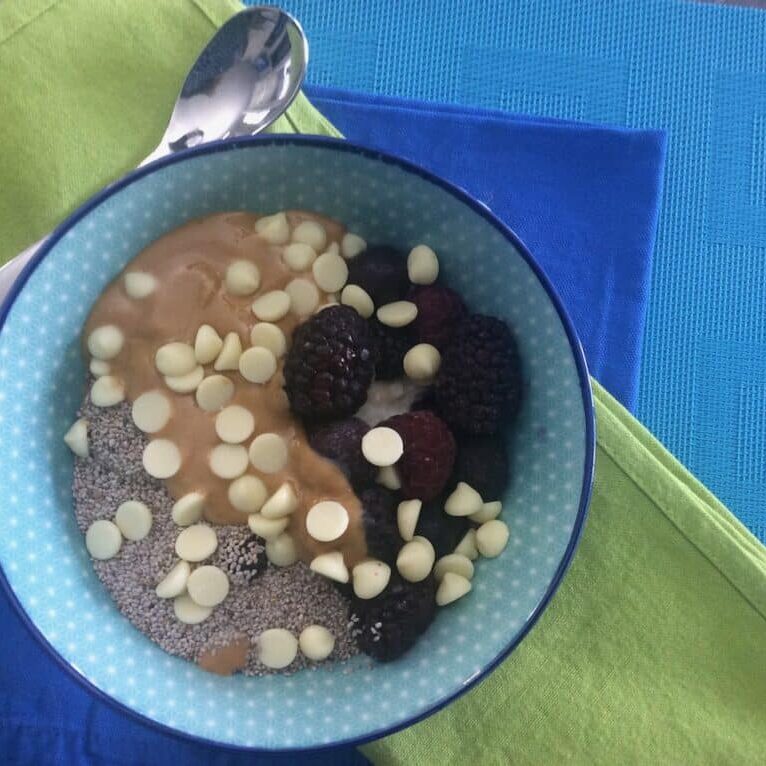What does 100 g of sugar look like relative to a 2000 kcal intake?
I partnered with the dietitians at the Canadian Sugar Institute to participate in this workshop and to share what I learned through this blog post. The information in this blog post contains guidelines from Health Canada, the recipes created by Andrea Holwegner of Health Stand Nutrition and incorporates my perspective drawing from over 20 years of practice.
What does 100 g of sugar look like? I don’t mean sugar from a sugar bowl. I mean, what does 100 g of both added and naturally occurring sugar look like in food, relative to a 2000 kcal diet?
This was the focus of a recent virtual cooking workshop that I attended via Zoom, lead by my colleague, dietitian Andrea Holwegner.
One hundred grams of sugar, both added and naturally occurring, is the reference amount of sugar used in the % Daily Value being added to our Canadian food label. You may be seeing these updated labels now; you will be seeing them by 2022.
How can this new 100 g of sugar reference amount be incorporated into a variety of eating patterns that include regular intake of vegetables, fruits, whole grains and protein-rich foods, while still allowing room for snacks, treats or some packaged foods?
This is what we explored in our Zoom cooking class. We cooked up a menu that Andrea created, showing us all what 100 g of sugar looks like, relative to a 2000 kcal diet. Let’s have a look at the full day’s menu.
Full Day’s Menu
Breakfast: Blueberry Pecan Baked Oatmeal cup with Plain 2% Greek Yogurt, 1 tbsp Maple Syrup and ½ cup Blueberries
Lunch: Asian Chicken Salad Bowls with a tall iced coffee with 2% milk
Snack: Strawberry Avocado Salsa
Supper: Easy Chickpea Burger with a multigrain bun with lettuce, tomato, pickle, ketchup mustard with a side of Apple Poppyseed Coleslaw
Dessert: 1 ounce of dark chocolate.
For those of you who enjoy numbers, the nutritional analysis of this menu is available at the end of this post.
Can your diet have room for food that is good for you and also offers soulful satisfaction? Yes! As you can see here – this was a menu that was flavourful, satisfying, and included room for things like dark chocolate!
Of course, there are many meal and snack variations that can create 100 g of sugar. Here is another sample menu showcasing 100 grams of sugar, relative to a 2000 kcal dietary pattern.
If you would like to see additional menu options for what 100 g of sugar % Daily Value for total sugars (both naturally occurring and added) looks like, you can go to the Sweet Spot Challenge website.
What does the Nutrition Label mean by sugar?
That depends! While “sugar” is used in both the Nutrition Facts table and the List of Ingredients, it doesn’t mean the same thing!
- “Sugars” in the Nutrition Facts Table represents total sugars, and includes both those from naturally occurring sources (fruits, vegetables and milk products) and those added to foods (sugar, brown sugar, honey, maple syrup, concentrated fruit juice and glucose-fructose).
- “Sugars” in the List of Ingredients represents sources of only added sugar. The new labeling regulations require all added sugar ingredients be grouped together in brackets following the term “sugars”. This does not include sugars naturally occurring in fruit, vegetables and dairy sources, nor high-intensity sweeteners like sugar alcohols or dextrins.
The Nutrition Facts Table and the % Daily Value: What you need to know
The Nutrition Facts Table lists the amount of total carbohydrate, including total sugars, starches and fiber in a stated serving size. However, it is hard to interpret just the grams of sugar alone. This is why a % Daily Value for Sugars will be added, so consumers can compare the sugar content of different foods and understand the relative amount of sugars in the context of their total daily food intake. A food with more than 15% Daily Value sugar has “a lot” of sugar while a food with less than 5% Daily Value has “a little” sugar.
The % Daily Value for sugar is set at 100 g, which is equivalent to 20% energy intake of a 2000 kcal diet. According to Health Canada, this value is not a recommended level of intake. Rather, it is the amount of total sugars consistent with a healthy eating pattern where sugars come from fruit, vegetables and plain milk, and is close to the average level of consumption of total sugars in Canada.
The % Daily Value is not a recommended amount. The grams per day will vary depending on your individual energy needs.
- The 100 g of sugar is based on 20% of energy intake, based on a 2000 kcal diet.
- If you need more energy or calories in the day, the % Daily Value relative to your energy intake will be higher.
- If you need less energy in the day, the % Daily Value relative to your energy intake will be lower.
If the % Daily Value includes both naturally occurring and added sugars, how will consumers be able to differentiate whether the sugars are naturally occurring versus sugars added during processing?
Consumers can turn to the ingredient list on the food label to find this information. The placement of sugars within the ingredient list will depend on the total weight of all the sugars ingredients combined. This placement will help make it easier for consumers to identify all the sources of sugars added to a food or beverage.
If you would like to learn more about how our Nutrition Labeling regulations will change, you can go to the Health Canada website.
When it comes to sugar, keep perspective
While plain yogurt has no added sugar, most people I know don’t enjoy plain yogurt without adding in some sweetener like maple syrup or honey to soften the tartness of plain yogurt. Adding in a bit of sweetness to our foods, whether that is in yogurt, when making a sauce, a muffin or other creation, helps to create a culinary product that is appealing and satisfying.
Some people may benefit from a lower carbohydrate dietary approach. If this is you, there are many ways to follow a lower carbohydrate dietary approach with a focus on whole, less processed foods. Ultimately, within a lower carbohydrate approach, we still need to find balance and satisfaction. When we eat foods that are satisfying, we discover a way of eating that we enjoy and can maintain.
I am not suggesting you dump in a bowlful of sugar to your food! Have a lesser amount of added sugar that feels enjoyable and satisfying to you. This starts by including more whole, less-processed foods as the basis for your meals. We don’t need extremes like joyless, no-sugar-added green smoothies. We need balance, starting with a balanced perspective.
When we have a healthful, balanced and maintainable approach with food, our diet has a place in our life, but does not consume our life. When this happens, we can focus on other things in our life that we enjoy like hobbies, activities, culture, recreation and things that lift our spirit. And when our this expanded focus happens, we add *life* to our life, through food and nutrition.
Nutritional Analysis for the Full Day’s Menu
| Calories (kcal) | Carbs (g) | Sugars (g) | Fibre (g) | Fat (g) | Saturated Fat (g) | Protein (g) | Sodium (mg) | |
| Breakfast | ||||||||
| Blueberry Pecan Baked Oatmeal Cups (1 muffin) | 135 | 17 | 6 | 2 | 6 | 1 | 4 | 98 |
| Plain 2% Greek Yogurt (3/4 cup) | 122 | 7 | 6 | 2 | 3.5 | 2 | 17 | 90 |
| Maple Syrup (1 tbsp) | 52 | 13 | 12 | 0 | 0 | 0 | 0 | 2 |
| Blueberries (1/2 cup) | 44 | 11 | 8 | 2 | 0 | 0 | 0.5 | 1 |
| Lunch | ||||||||
| Asian Chicken Salad (1 serving) | 496 | 59 | 11 | 6 | 14 | 2 | 35 | 870 |
| Tall Iced Coffee with 2% Milk | 80 | 17 | 17 | 0 | 1 | 0.5 | 2 | 30 |
| Snack | ||||||||
| Strawberry Avocado Salsa (1 serving) | 118 | 11 | 3 | 4 | 8 | 1 | 2 | 80 |
| Tortilla Chips (12 chips) | 170 | 24 | 0 | 2 | 7 | 1 | 2.5 | 0118 |
| Dinner | ||||||||
| Easy Chickpea Burger (1 burger) | 240 | 33 | 5 | 5 | 7 | 1 | 11 | 95 |
| Multigrain Bun (1 bun) | 113 | 19 | 3 | 2 | 2.5 | 0.5 | 4 | 197 |
| Toppings – Lettuce, Tomato, Pickle, Ketchup, Mustard | 27 | 6 | 4 | 1 | 0 | 0 | 1 | 258 |
| Apple Poppyseed Coleslaw (1 serving) | 238 | 23 | 17 | 3 | 16 | 2 | 2 | 170 |
| Dessert | ||||||||
| Dark Chocolate, 70% (3 squares, 30 g) | 170 | 14 | 9 | 4 | 12 | 7 | 3 | 10 |
| Totals | 2,005 | 254 | 101 | 33 | 77 | 18 | 84 | 2,019 |
I partnered with the dietitians at the Canadian Sugar Institute to participate in this workshop and to share what I learned through this blog post. The information in this blog post contains guidelines from Health Canada, the recipes created by Andrea Holwegner of Health Stand Nutrition and incorporates my perspective drawing from over 20 years of practice.
#CSIHomeSweetHome @CdnSugarNutr
Tagged in: 100 g sugar, Calgary Dietitian, Calgary Nutritionist, food label, meal ideas, menu, midlife nutrition, Real food, recipes, sugar
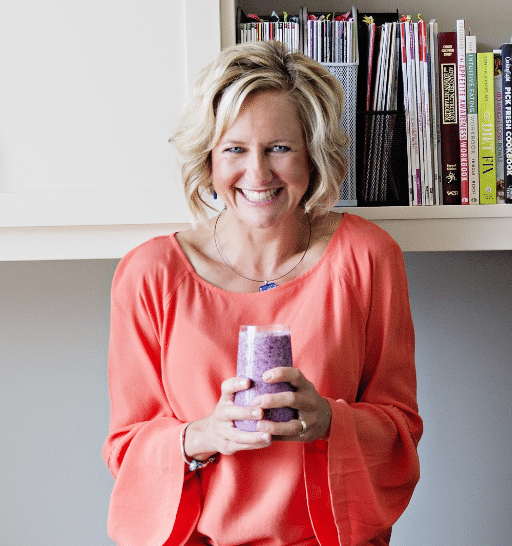

Welcome to the Energize Nutrition blog, where we share evidence-based nutrition content, designed to empower people’s midlife. Take a look around to find information on feeling your best.
If you need more individualized support, reach out to set up a free discovery call with Kristyn Hall.

Battling chronic hunger, poor energy, or inflammation? Discover what this powerful ingredient is and why it might be the solution!
